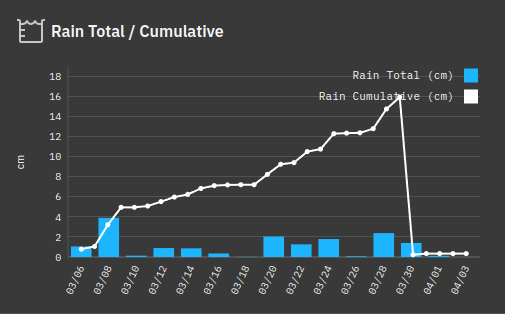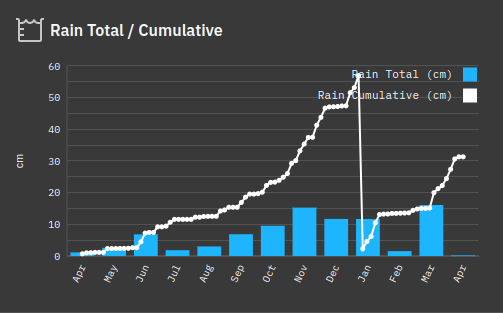-
-
Notifications
You must be signed in to change notification settings - Fork 14
Code Snippets
Using weewx-GTS
Add a combined diagram of GTS, yearGDD and seasonGDD in skin.conf.
[DisplayOptions]
[[diagrams]]
[[[combined_observations]]]
[[[[vegetation]]]]
label = "Vegetation"
aggregate_type = avg
markerValue = 200
markerColor = "#FF7518"
yScaleMin = 0
pointSize = 3
[[[[[obs]]]]]
[[[[[[GTS]]]]]]
observation = GTS
aggregate_interval = 86400 # 1 day
curve = "linear"
color = "#50C878"
[[[[[[yearGDD]]]]]]
observation = yearGDD
curve = "linear"
color = "#F88379"
[[[[[[seasonGDD]]]]]]
observation = seasonGDD
curve = "linear"
color = "#40B5AD"
This can be used with the month, year and alltime timespans:
[DisplayOptions]
...
[[diagrams]]
...
[[[month]]]
...
[[[[observations]]]]
[[[[[vegetation]]]]]
...
[[[year]]]
...
[[[[observations]]]]
[[[[[vegetation]]]]]
...
[[[alltime]]]
...
[[[[observations]]]]
[[[[[vegetation]]]]]
...

Using weewx-xcumulative
Add a combined diagram of Total rain and cumulative rain for different time spans:
Day:
[[diagrams]]
...
[[[combined_observations]]]
[[[[rain_cum_sum]]]]
label = 'Rain Total / Cumulative'
yScaleMin = 0
[[[[[obs]]]]]
[[[[[[rain_sum]]]]]]
observation = "rain"
aggregate_type = sum
aggregate_interval = 7200 # 2 hours
[[[[[[rain_cum]]]]]]
observation = "rain"
color = "#ffc000"
type = line
aggregate_type = cumulative
aggregate_interval = 7200 # 2 hours
reset = midnight
curve = linear
Month:
[[diagrams]]
...
[[[combined_observations]]]
[[[[rain_cum_sum]]]]
label = 'Rain Total / Cumulative'
yScaleMin = 0
[[[[[obs]]]]]
[[[[[[rain_sum]]]]]]
observation = "rain"
aggregate_type = sum
aggregate_interval = 172800 # 2 days
[[[[[[rain_cum]]]]]]
observation = "rain"
color = "#ffc000"
type = line
aggregate_type = cumulative
aggregate_interval = 86400 # 1 day
reset = month
curve = linearYear:
[[diagrams]]
...
[[[combined_observations]]]
[[[[rain_cum_sum]]]]
label = 'Rain Total / Cumulative'
yScaleMin = 0
bottom_date_time_format = "%b"
[[[[[obs]]]]]
[[[[[[rain_sum]]]]]]
observation = "rain"
aggregate_type = sum
aggregate_interval = month # 18 days
[[[[[[rain_cum]]]]]]
observation = "rain"
color = "#ffc000"
type = line
aggregate_type = cumulative
aggregate_interval = 345600 # 4 days
reset = year
curve = linearStatistics:
[[diagrams]]
...
[[[combined_observations]]]
[[[[rain_cum_sum]]]]
label = 'Rain Total / Cumulative'
yScaleMin = 0
[[[[[obs]]]]]
[[[[[[rain_sum]]]]]]
observation = "rain"
aggregate_type = sum
aggregate_interval = month
[[[[[[rain_cum]]]]]]
observation = "rain"
color = "#ffc000"
type = line
aggregate_type = cumulative
reset = year
curve = linearFirst, add the configuration to skin.conf, under the combined_observations key:
[[[combined_observations]]]
[[[[my_custom_chart]]]]
label = "My custom Chart"
curve="natural"
[[[[[obs]]]]]
[[[[[[rain]]]]]]
observation = "rain"
[[[[[[outTemp]]]]]]
observation = "outTemp"
Then, add this to the template where you want the chart to be rendered.
<div class="bx--row">
#set global $comb_obs = "my_custom_chart"
#set global $combined_diagram = $DisplayOptions.get("diagrams", {}).get("combined_observations", {}).get('my_custom_chart', {})
#set global $diagram_index = 9999
#include "includes/combined-diagram-tile.inc"
</div>
This assumes, that you add the chart to a context page, eg. index.html, week.html, month.html, year.html, etc. This way the TimeSpan will be set automatically. If you want to set the TimeSpan manually, you can do so setting the following:
<div class="bx--row">
#attr $context = 'custom'
#set global $context_start_ts = 1672537657
#set global $context_end_ts = 1675129657
#set global $diagram_classes_custom = "bx--col"
#set global $comb_obs = "my_custom_chart"
#set global $combined_diagram = $DisplayOptions.get("diagrams", {}).get("combined_observations", {}).get('my_custom_chart', {})
#set global $diagram_index = 9999
#include "includes/combined-diagram-tile.inc"
</div>
#attr $context = 'custom' Set a custom context
#set global $context_start_ts Set a custom start time, needs to be a timestamp.
#set global $context_end_ts Set a custom end time, needs to be a timestamp.
You can use https://www.epochconverter.com/ to get the timestamp of a specfic date.
#set global $diagram_classes_custom = "bx--col" Per default the diagrams are rendered in a 3 column layout. If you want to change this, you can set the classes here. For example, if you want to render the diagram over the whole page, just use "bx--col".
<div class="bx--row">
<div class="bx--col">
<div class="bx--tile">
<p>Place your content here</p>
</div>
</div>
</div>

<div class="bx--row">
<!--Column 1-->
<div class="bx--col-sm-4 bx--col-md-8 bx--col-lg-12 bx--col-xlg-6">
<div class="bx--tile">
<p>Place your content here</p>
</div>
</div>
<!--Column 2-->
<div class="bx--col-sm-4 bx--col-md-8 bx--col-lg-12 bx--col-xlg-6">
<div class="bx--tile">
<p>Place your content here</p>
</div>
</div>
</div>

<div class="bx--row">
<!--Column 1-->
<div class="bx--col-sm-4 bx--col-md-8 bx--col-lg-12 bx--col-xlg-6" style="margin-bottom: 1rem;">
<div class="bx--tile">
<p>Place your content here</p>
</div>
</div>
<!--Column 2-->
<div class="bx--col-sm-4 bx--col-md-8 bx--col-lg-12 bx--col-xlg-6" style="margin-bottom: 1rem;">
<div class="bx--tile">
<p>Place your content here</p>
</div>
</div>
<!--Column 3-->
<div class="bx--col-sm-4 bx--col-md-8 bx--col-lg-12 bx--col-xlg-6" style="margin-bottom: 1rem;">
<div class="bx--tile">
<p>Place your content here</p>
</div>
</div>
<!--Column 4-->
<div class="bx--col-sm-4 bx--col-md-8 bx--col-lg-12 bx--col-xlg-6" style="margin-bottom: 1rem;">
<div class="bx--tile">
<p>Place your content here</p>
</div>
</div>
</div>

Tip: bx--tile renders a tile component, the 2 Column layout without tiles would look like this:
<div class="bx--row">
<!--Column 1-->
<div class="bx--col-sm-4 bx--col-md-8 bx--col-lg-12 bx--col-xlg-6">
<p>Place your content here</p>
</div>
<!--Column 2-->
<div class="bx--col-sm-4 bx--col-md-8 bx--col-lg-12 bx--col-xlg-6">
<p>Place your content here</p>
</div>
</div>

For more about IBM Carbon Grid System, see https://carbondesignsystem.com/guidelines/2x-grid/implementation

